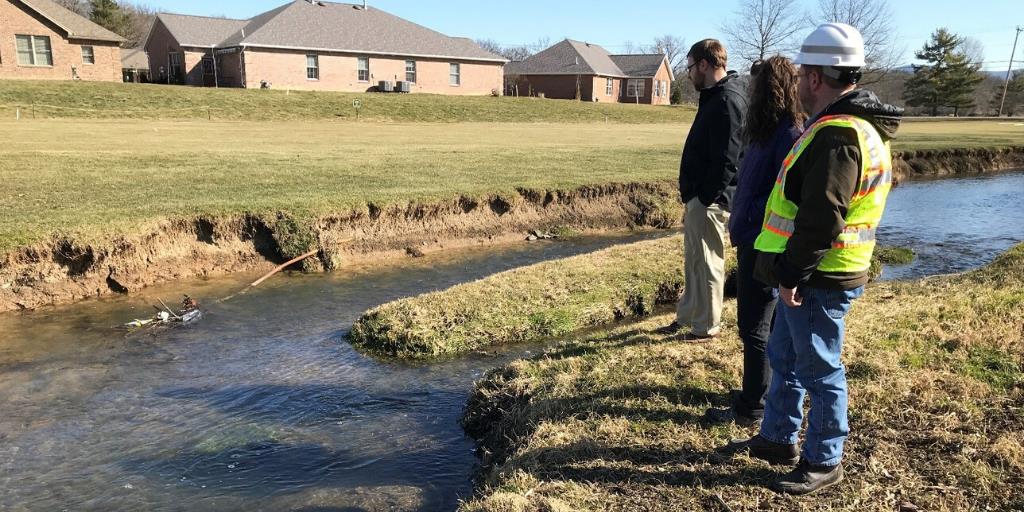
When District 9 was charged with creating projects designed to reduce pollutants carried by stormwater that flows to the Chesapeake Bay, they reached out to a group of local municipalities faced with same daunting task.
Sediment reduction commitments aren't unique to District 9, they are part of PennDOT's statewide Municipal Separate Storm System or MS4 - National Pollutant Discharge Elimination System (NPDES) Permit administered by the Department of Environmental Protection. All Districts have a share of the responsibilities to reduce pollutants entering the five major watersheds across the Commonwealth.
Similarly, many municipalities within urban areas must also reduce the pollutants entering the stormwater which drains to the streams, lakes and rivers.
In Blair County, the Blair County Intergovernmental Stormwater Committee (Blair ISC) was developed to consolidate the resources of several municipalities and meet the requirements of their MS4 NPDES Permits.
Partnering with other MS4 permittees such as the Blair ISC is an effective way to share the costs associated with constructing stormwater control measures since both groups can obtain credit for their individual pollutant reduction plans. Partnering also expands the search area for suitable sites to include land outside of PennDOT's right-of-way. Design, construction, maintenance and monitoring tasks are shared between the parties.
In the coming months, District 9 and the Blair ISC will be developing a stream restoration project on private land aimed at reducing pollutants which enter the stormwater. This kind of partnership is a win for both parties and a good reminder of what we can accomplish when we team up with others.
ABOUT THIS BLOG
Did you know PennDOT is directly responsible for nearly 40,000 miles of highway and roughly 25,000 bridges? We oversee programs and policies affecting highways, urban and rural public transportation, airports, railroads, ports and waterways, in addition to administering the state's more than 11 million vehicle registrations and 8.8 million driver's licenses.
So, how do we do what we do? And how can we help you travel in Pennsylvania — whether it be for business or leisure — in safe and enjoyable manner? Read PennDOT Way to learn more about the department, what we do, and how and why we do it.
TAGS
50-Year Anniversary, 511PA, Aggressive Driving, Airports, Autonomous Vehicles, Bicycles, Bridges, Child Safety, Community Relations, Construction, COVID-19, Distracted Driving, District 1, District 10, District 11, District 12, District 2, District 3, District 4, District 5, District 6, District 8, District 9, DOTcom, Driver and Vehicle Services, Emergency Responders, Employment, Equity, FAQ Friday, Human Trafficking, Impaired Driving, Innovations, Live Free Ride Alive, Maintenance Monday, Motorcycles, Older Drivers, PA Motorcycle Safety Program, Pedestrians, PennDOT Connects, Ports, Public Transit, Railroads, REAL ID, Road MaP, Roadside Beautification, Rural Roads, Safety, School Buses, Seat Belts, State Transportation Innovation Council (STIC), Sustainability, Teen Drivers, Throwback Thursday, Transportation Funding, Travel in PA, Welcome Centers, Winter, Work Smart, Work Zone, Yellow Dot
LATEST POSTS
PennDOT Continues Sharing, Updating Resources for Local Governments to Pursue Bipartisan Infrastructure Law Funding Opportunities
Norwin High School Wins 2024 ‘Innovations Challenge’
Demo Complete: I-95 CAP Project in Center City Philadelphia
PennDOT Archeologist Connects Past, Present, and Future
Lehigh Valley DUI, Highway Safety Task Force Hosts Law Enforcement Seminar
ARCHIVES
2024
2023
2022
2021
2020
2019
2018
2017

